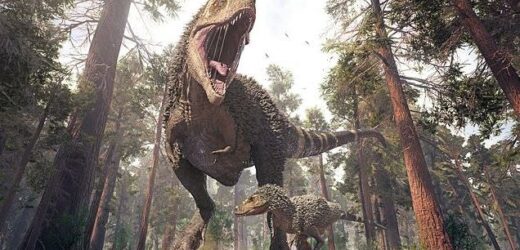The teen T.Rex takeover! Everywhere tyrannosaurs rose to dominance, their juveniles took over and wiped out all other medium-sized predators, study finds
- Medium predators dropped off in Asia and North America 95-80m years ago
- However, T.Rex and smaller prey were still around in abundance
- Scientists suggest teen T.Rex – which was also medium-sized – outcompeted its fellow medium-sized rivals
It’s often referred to as the ‘King of the Dinosaurs’, and now a new study has revealed that T.Rex was a tyrant from a young age.
Researchers from the University of Maryland suggest that everywhere T.Rex rose to dominance, their juveniles took over and wiped out all other medium-sized predators.
While previous research has suggested that medium-sized predators disappeared due to a lack of prey, the new findings suggest that teen T.Rex may actually be to blame.
Scroll down for video
Researchers from the University of Maryland suggest that everywhere T.Rex rose to dominance, their juveniles took over and wiped out all other medium-sized predators
WHAT WAS T. REX?
Tyrannosaurs rex was a species of bird-like, meat-eating dinosaur.
It lived between 68–66 million years ago in what is now the western side of North America.
They could reach up to 40 feet (12 metres) long and 12 feet (4 metres) tall.
More than 50 fossilised specimens of T.Rex have been collected to date.
The monstrous animal had one of the strongest bites in the animal kingdom.
An artist’s impression of T.Rex
In the study, the team set out to understand why there was a dramatic drop-off in diversity of medium-sized predators in lands that eventually became central Asia and Western North America around 95 to 80 million years ago.
Thomas Holtz, who led the study, said: ‘Earlier in the history of dinosaurs, in most communities you’d have a bunch of different types of carnivores of various size ranges from small fox-sized all the way up to the occasional giants.
‘Then something happens between 95 and 80 million years ago, where we see a shift.
‘The really big carnivores, larger than an elephant, like tyrannosaurs and their kin, become the apex predators, and the middle-sized predators, say leopard to buffalo-sized carnivores, are either missing or very rare.’
In previous research, the team found that young tyrannosaurs were faster and more agile than their parents, and likely hunted prey similar to medium-sized dinosaurs.
Now, they suggest that as T.Rex evolved and grew, their juveniles outcompeted other carnivorous dinosaurs.
However, the team acknowledges that it is also possible that something else eliminated the other dinosaurs, and T.Rex simply filled the gap.
‘Ultimately resolving that is going to rely on the most basic first-level aspect of paleontology, which is boots on the ground and picks in the sediments,’ Mr Holtz said.
‘We need more sampling sites from this interval between about 95 and 80 million years ago.’
In the study, the researchers analysed the existing record of 60 dinosaur communities from 201 to 66 million years ago.
They counted the number of carnivorous species and sorted them into size categories, with ‘medium’ dinosaurs listed as those weighing 50 to 1,000kg, and ‘large’ dinosaurs as those exceeding 1,000kg.
The analysis revealed that in 31 communities, tyrannosaurs were not the largest predators, and there was a wide range of medium predators.
In Asia and North America, those communities existed from 201 to 80 million years ago, while in other areas, they continued to exist through to 66 million years ago.
They counted the number of carnivorous species and sorted them into size categories, with ‘medium’ dinosaurs listed as those weighing 50 to 1,000kg, and ‘large’ dinosaurs as those exceeding 1,000kg
Meanwhile, in the other 29 dinosaur communities, tyrannosaurs were the largest predator, with medium-sized predators either rare or absent.
Despite this, prey species were found to be just as diverse in these communities.
Mr Holtz explained: ‘So, what does this mean? In those communities where middle-sized predators are gone but the prey species are just as diverse, can we say that no one is preying upon these middle-sized prey? No.
‘That’s almost certainly not the case. It is quite likely juvenile tyrannosaurs took over the ecological role of the missing middle-sized carnivores.’
The team now hopes to look further into the composition of prey species communities to uncover whether or not there was a change in prey size when T.Rex took over.
Mr Holtz added: ‘These interactions are important for understanding what life was like during the time of the dinosaurs.
‘But in the broader sense, having more understanding of changing ecosystems, and in this case, looking at the predator and prey components of an ecosystem, gives us a better and more diverse view of how the interactions of life work in the world, even today.’
HOW THE DINOSAURS WENT EXTINCT AROUND 66 MILLION YEARS AGO
Dinosaurs ruled and dominated Earth around 66 million years ago, before they suddenly went extinct.
The Cretaceous-Tertiary extinction event is the name given to this mass extinction.
It was believed for many years that the changing climate destroyed the food chain of the huge reptiles.
In the 1980s, paleontologists discovered a layer of iridium.
This is an element that is rare on Earth but is found in vast quantities in space.
When this was dated, it coincided precisely with when the dinosaurs disappeared from the fossil record.
A decade later, scientists uncovered the massive Chicxulub Crater at the tip of Mexico’s Yucatán Peninsula, which dates to the period in question.
Scientific consensus now says that these two factors are linked and they were both probably caused by an enormous asteroid crashing to Earth.
With the projected size and impact velocity, the collision would have caused an enormous shock-wave and likely triggered seismic activity.
The fallout would have created plumes of ash that likely covered all of the planet and made it impossible for dinosaurs to survive.
Other animals and plant species had a shorter time-span between generations which allowed them to survive.
There are several other theories as to what caused the demise of the famous animals.
One early theory was that small mammals ate dinosaur eggs and another proposes that toxic angiosperms (flowering plants) killed them off.
Source: Read Full Article




